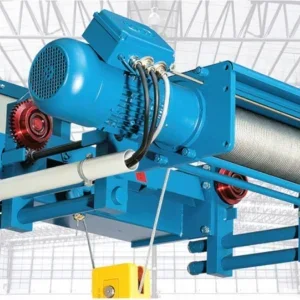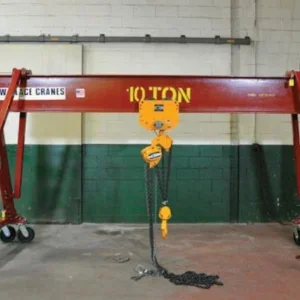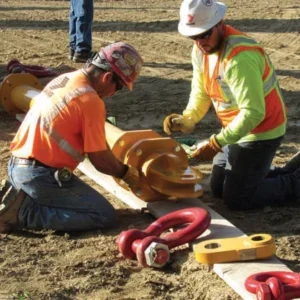Manually operated suspended crane assemblies such as a gantry crane or bridge crane are used in a great variety of industrial and other applications for lifting and moving objects. Suspended crane assemblies can be designed to lift and move any practical weight.
One problem with existing assemblies occurs when an operator attempts to initiate movement of the bridge in either direction relative to the guides. The effort required to initiate such movement is often considerable, at least in part owing to the fact that movement of the other end of the bridge is initiated. This can cause the bridge to twist relative to the stationary guides, and thereby jam and prevent further movement.
Another problem with existing assemblies is the fact that the guides must be aligned parallel or very close to parallel during installation. If not, the bridge tends to jam in the guides preventing further movement.
It is an object of the invention to overcome or alleviate one or more of the above problems of lifting assemblies or to provide the consumer with a useful commercial choice.
According to one aspect, the present invention provides a lifting assembly comprising: a pair of parallel guides; a carriage associated with each parallel guide and movable along the length of said guide; a connection means pivotally connecting each said carriage to one end of a bridge; and an attachment means associated with the bridge; wherein said connection means includes a universal connection to absorb rotational and lateral motions of the bridge when a force is applied to the attachment means.
It is to be appreciated that the assembly does not include the lifting device, or part thereof. The inclusion of the lifting device in the discussion of the present invention is merely provided to define the context of the invention.
Most preferably, each bridge is longitudinally displaceable relative to the carriages. This further prevents the carriages from jamming on/in the guides. In one preferred form, the longitudinal displacement is provided by way of a displacement arm, which is pivotally connected at either end, respectively, to the bridge and the carriages. However, longitudinal displacement could occur via any other suitable arrangement.
The pivotal connection of the carriages to the bridge could adopt any suitable form. The pivotal connection acts as a universal joint with the displacement arm. The pivotal connection enables the carriages to commence movement along one guide prior to the carriages commencing movement along the other guide(s). This pivotal connection effectively absorbs lateral and axial movement of the bridge and translates applied force into longitudinal movement of the bridge along the guides. This has been found to reduce the exertion necessary to initiate movement of the carriages. It has also been found to reduce the incidence of the carriages becoming jammed on/in the guides. The displacement arm is also pivotally connected to a bridge sleeve which is rigidly fixed to the bridge.
[0027] Fig. 1 is a perspective view of an overhead lifting assembly according to an embodiment of this invention; [0028] Fig. 2 is a front view of a carriage illustrated in Fig. 1; [0029] Fig. 3 is a partial cross-sectional view of the carriage illustrated in Fig. 2; [0038] FIG. 12 A plan view of guides that are in a curved or non-linear but preferably still parallel conditionExplanation of the drawings
Two substantially parallel guides 18, 20 are provided. The bridge 14 is movable longitudinally relative to the parallel guides 18, 20. In the illustrated embodiment of the invention, the bridge 14 is manually movable relative to the parallel guides 18, 20. Again, however, it is to be appreciated that the bridge 14 could be electrically movable relative to the parallel guides 18, 20.
The parallel guides 18, 20 as shown formed from an open channel C-section are respectively provided with openings 22, 24.
In the illustrated embodiment the parallel guides 18, 20 are rigidly secured to a building ceiling, roof or separate superstructure (not illustrated). However, it is to be appreciated that the parallel guides 18, 20 could be provided with some movement relative to their mountings, if desired.
The bridge 14 includes carriage 26, 28. The carriages 26, 28 are provided for travelling along the parallel guides 18, 20 respectively. The relationship and configuration of the carriage 26 and the guide 18 is substantially identical to that of the carriage 28 and the guide 20. Therefore, the following description refers only to the carriage 26 and the guide 18.
The carriage 26, or similar device, is movable along the parallel guides 18, 20, and includes at least one mounting plate 30. The mounting plate 30 is configured to travel longitudinally along the parallel guide 18 by way of rollers 32, 34, 36, 38, which are rotatably mounted to the mounting plate 30. The carriages 26, 28 bear the weight of the bridge 14 and the crane (not illustrated), which is, in turn, borne by the parallel guides 18, 20. An additional mounting plate 30 may be used external of the profile (I-beam).
Existing crane assemblies tend to jam when an operator initiates movement of the bridge (comparable to the bridge 14) along the assembly guides (similar to guides 18, 20). This is, in part, a result of the rigid connection in existing crane assemblies of the bridge to the carriage.
To address this problem, the present invention includes a displacement arm 40. The displacement arm 40 is constructed from mild steel, or higher-grade steel, generally from steel plate or steel strip. Alternatively, the displacement arm 40 could be constructed from any other suitable material. The displacement arm 40 is pivotally connected to a sleeve 42. The sleeve 42 is rigidly fastened (by any suitable means) to the mounting plate 30. The figures show the mounting plate 30 welded to the sleeve 42, but other means of rigid attachment such as bolting could be used. The pivotal connection between the displacement arm 40 and the sleeve 42 is by way of a ball bearing 44. The ball bearing 44 is retained in place by a ball bearing seat 46 provided in the displacement arm 40 and the sleeve 42, respectively. The ball bearing 44 could be manufactured from any suitable grade of steel, or any other suitable material. The bearing seat is formed from a plastic, such as nylon, to minimise friction, but could be formed from other suitable materials.
The displacement arm 40 is pivotally connected to a bridge sleeve 50 (see Figs. 2 and 3) which, in turn, is securely connected to one end of the bridge 14. The bridge sleeve 50 is constructed from steel. Any suitable grade steel (or any other material) could be used in the construction of the bridge sleeve 50. The displacement arm 40 is pivotally connected to the bridge sleeve 50 by two fasteners 52, 54 via displacement arm appendages 56, 58. The fasteners 52, 54 provide a pivotal connection between the displacement arm 40 and the bridge sleeve 50.
The above arrangement forms a universal joint that provides the necessary relative pivoting and lateral movement between the carriage 26, 28 and the bridge 14 to at least reduce the incidence of jamming of the lifting assembly 10, upon initiating movement of the bridge 14 relative to the parallel guides 18, 20.
In Fig. 4 is a plan view of guides 18, 20 that are in a curved or nonlinear configuration. The present invention conveniently lends itself to allowing for the movement of a bridge 14 guided by guides 18, 20 around a curved or nonlinear locus. Any nonalignment issues are accommodated because of the degree of freedom incorporated. Whilst in the most preferred form the guides 18, 20 will remain parallel throughout any linear or nonlinear transition of support to the bridge 14, such need not necessarily always occur. In travelling about a curved guide, the bridge 14 may not always remain perpendicular to the tangent of both guides 18, 20. As such the degrees of freedom provided by the carriages 26, 28 allow for convenient movement of the bridge 14 around such transition regions. It may well be that the entire guide is of a nonlinear configuration or that only part of the guide is nonlinear, other parts being substantially rectilinear.






